If you live in a property without enough electrical sockets, this can be a real pain as in most cases you then may need to resort to using less than desirable extension leads and the likes, however there may be a solution in the form of extending a ring main to provide extra sockets.
What is a Ring Main?
A ring main or ring final circuit is a domestic electrical circuit used to power the electrical sockets in your home. Electrical cable, usually 2.5mm twin and earth runs from your consumer unit to all sockets on the circuit and back to the consumer unit in a loop.
The ring main circuit was developed in the UK where it is the main form of circuit used for sockets today, preferred rather than the radial circuit.
The main reason for its development was that it allowed the use of smaller, cheaper diameter cables than those that would have to be used in a radial circuit to carry a reliable current to the same capacity.
Staying Safe When Working Around Electricity
As we all know, electricity is extremely dangerous and when working around it you must take the utmost care.
To this end, before any work takes place, the circuit that is being worked on MUST be isolated at the consumer unit or fuse box! This means the breaker/MCB needs to be turned off or the fuse removed.
Once done, a note should be placed on the MCB or breaker informing everyone that the circuit is being worked on and has been tuned off for a reason. For more information checkout our electrical safety project here.
Additionally, depending on how old you property is, it may feature old wiring of red live, black neutral and yellow/green earth which will be of a different colour to the newer colour scheme of brown live, blue neutral and yellow/green earth.
For full information all about this colour change and staying safe whilst working with different cable colours, see our wire colours project here.
Rules for Extending a Ring Main
Although it is certainly possible to extend a ring main, there are some rules that have to be followed.
The first rule is that the maximum floor area that a ring main can serve is 100 square metres and no more. It must also be protected by a 32amp MCB or 30amp fuse if it’s running from a board with cartridge fuses.
You are also limited in the length of cable you are allowed to use with a ring main circuit. 50 metres when it’s protected by an MCB and 60 metres when protected by a cartridge fuse. Also, any long spurs running from the circuit could make you exceed the limit, so be aware of this.
The next rule or point to be aware of that often crops up when discussing ring circuits is the number of sockets that can feature. In answer to this the number is in fact unlimited, you can have as many 13A sockets on a ring main as you want, as long as it doesn’t exceed the total floor area of 100 square metres.
Although there is no limit, this has to be taken with a pinch of salt as, for example, if you have 100 tumble dryers on a single circuit all running at the same time the current draw would be so massive that it would overload the circuit in seconds, so this rule is within reason.
You should also remember that any electrical work undertaken needs to be tested by a competent person e.g. a professional electrician with the means to fully test the circuit, especially with jobs such as these are the earth path is being extended.
Once tested and confirmed safe, a minor works certificate is then issued to confirm the works undertaken. This certificate can then also be used to confirm with your home insurance provider that all work has been done correctly so that your insurance won’t be affected, as if something happens and the work has not been checked then this could affect how you are insured.
The final rule to be aware of relates to where any new sockets are positioned as there are rules on how high they need to be above floor level and how far from any corners so that less able bodied users can easily access them. For full information on this see our socket height project here.
Can a Ring Main be Extended?
It is not particularly difficult to extend a ring main but you must remember that certain rules apply about the floor area and length of cable one ring main may serve and use. These rules can be found in our ring main project. These rules apply to spurs also.
So in short, yes a ring main can be extended from it’s existing length to feature a series of new sockets as long as a certain rules are followed in terms of its length and the amount of floor area in square meters it covers.
Different Ways of Extending a Ring Main
There are 2 different methods that are commonly used to extend a ring main. The first and most popular is to use 2 30amp junction boxes and the other is to use 2 existing sockets.
- Junction Boxes: A length of existing ring main cable is traced and cut once the power has been isolated. A junction box is installed at either cut end and a new length of cable installed between junction boxes to create an extension.
- Existing Sockets: 2 sockets are identified on an existing ring main. The cable running between the 2 sockets is replaced with a longer length that then features a selection of new sockets
There isn’t really much difference between the 2 methods but generally using junction boxes is a little easier as things tend to be a little more accessible.
More often than not it’s easier to access existing wiring in the loft and create your new extension here, especially if you are adding sockets upstairs, however if it’s for a ground floor then you may need to pull up floor boards and create the extension here.
When using junction boxes it’s important that they are fixed to a surface. Normally this tends to be a rafter. In respect to this, generally they are fixed to the inside of a rafter but this makes access and wiring difficult so it’s better to fix a piece of timber over the top or 2 rafters and fix to this.
You must also ensure that any new junction boxes and cabling are not covered in insulation as this can cause them to overheat and potentially catch fire!
In terms of running cables, in most case you’re not going to want to surface mount anything as this looks untidy so new cables are going to need to be chased into walls, unless it’s a stud wall and they can be pulled or fished through.
When it comes to running cables to sockets there are also strict rules on how this should be done. Cables supplying sockets should only be run vertically from ceiling to floor or horizontally from each side of the socket out to a room corner, door or similar object. More information on this can be found in our electrical safe zones project here.
How Many 13A Sockets can be on a Ring Main?
There is no limit to the number of 13A sockets that can be placed within a ring main but you have to ensure that it doesn’t exceed the total floor area of 100 square metres or 50 metres in length when connected to an MCB (60 metres when running off of a cartridge fuse).
Despite this there are limits as running too many high demand appliances off of too many sockets on the same ring main could lead to overload and the possibility of over heating and fire.
Tools and Products Needed for Extending a Ring Main
To successfully extend a ring main you will need the following tools and products:
- 2x 30amp junction boxes (if using junction boxes)
- Small flat blade screwdriver
- Philips screwdriver
- Utility knife
- Wire strippers
- Suitable length of 2.5mm twin and earth
- Desired number of new sockets and back boxes
- Chasing machine (if needed)
- Timber for making mounts for junction boxes
- Selection of screws
- Filler to fill chases
- Electrical fishing cables
How to Extend a Ring Main
For the purposes of this example we are going to extend an existing ring main using junction boxes. We are also going to work on the basis that we are installing into a plasterboard stud wall.
The diagrams below show how you can break into a ring main with junction boxes to extend it, which is the exact method we are going to use here.
The first image shows a simple ring main to and from the consumer unit

Ring main
The image below shows the main extended via 2 new 30 amp junction boxes.
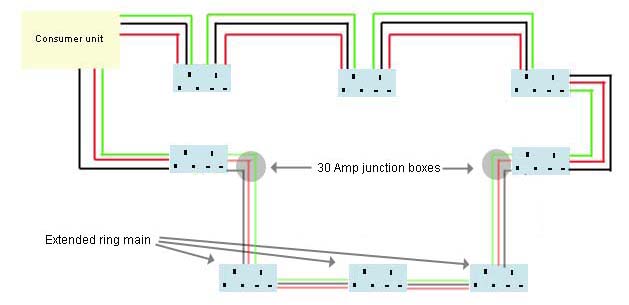
Extended ring main
Step 1 – Plan the Extended Ring Main
When extending a ring main or ring circuit, the first thing to do before running any form of cabling is to plan out exactly where each of your new sockets is going to go and where you are going to run the cables to.
This is important to do as to minimise any disruption in terms of how long the power is going to be off for, it’s a good idea to install the new sockets and wiring and then connect up to each junction box and then once this is done you can then simply turn the power off for 20 or 30 minutes or so while you connect the cut end of the existing ring main cable to each junction box.
The planning stage will also allow you to work our where’s best to run the new wiring to as you can visually inspect the loft area and also figure out if you have solid walls or stud walls. When you know this you will then be able to decide whether it’s best to run wiring down from the loft or pull up some floor boards and run vertically up to each socket.
In a lot of cases it’s sometimes best to run up from the floor under the floorboards as quite often there will be a timber running horizontally between vertical studs preventing you from pulling any cables all the way down through the cavity of a stud wall.
Once you’ve decided how to run the cabling also think about where the sockets are going to go and what, if any, obstructions may be in the way.
Finally, you will also need to identify a suitable part of an existing ring main you’re going to cut into, to take a feed from and also where each junction box is going to go.
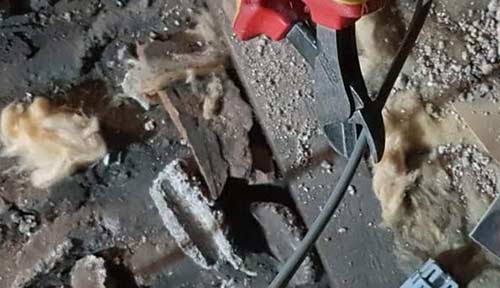
Suitable location to cut into existing ring main cable
Step 2 – Cut out Back Boxes
Once you know how you’re going to run the cabling, the next job is to mark out on the wall exactly where each of your new sockets is going to go. Mark on the wall the exact location for the socket. Ensure that it is at least the required 450mm up from floor level.
Once marked, take a back box, position it on the wall, level it using a spirit level and draw around it to mark the area that needs to be cut out of the plasterboard for it to fit. This would be the same process for fitting in a solid wall, only it would need to be chased out rather than cut out and you will also probably need to chase out cable channels for the supply cables to run to and from each socket.
As we’re installing into plasterboard we need to use plasterboard socket back boxes, however if you’re chasing into a solid wall you’ll need to use metal back boxes.
In terms of fixing, plasterboard back boxes should just slip into place using the wings at either side of the to clip and hold it while, with metal back boxes, you will need to mark through the fixing hole, drill it out, insert a wall plug and then screw it in place.
Repeat the above steps for any other sockets you’ll be installing, ensuring that each is position correctly in terms of the regulations.
Step 3 – Run new Cable
Once All your socket locations are cut or chased out the next job is to run the cabling from the location you have identified to cut the existing ring main, out to each socket location and then back to the cut in point.
Using a suitable length of 2.5mm twin and earth and also a second pair of hands if needed, run the cable from the start out to the first socket hole. Pull roughly 12 inches of cable through the hole and then squeeze it in half so make a loop. This loop is cut when installing the face plates to give a feed to and from the socket.
Repeat the above steps for any more socket holes you have and then run the other end of the cable back to the start.
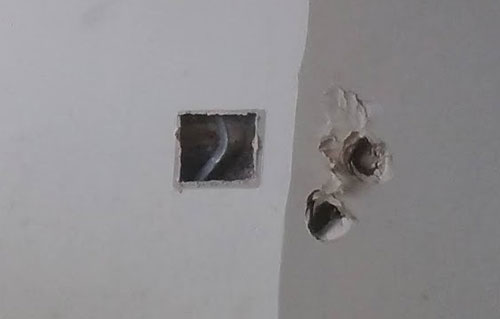
Cable run to and from existing ring main cable to sockets
Step 4 – Connect up new Sockets
Once the new supply cable has been run to and from each socket, you can then connect up each faceplate. Using some wire cutters simply cut through the centre of the loop and strip the outer cable sheath back as much as needed and expose the inner cores. Hold the cable up to the rear of the faceplate and gauge how much needs to be stripped to reach each terminal. Do this for both ends of the cut cable.
Using some wire strippers, strip off the core wire and fix each cut end of each internal core, live, neutral and earth to it’s respective terminal on the rear of the face plate. Do this for both cut pieces of cable so that each terminal has 2 wires in it.
This will ensure that power runs to the new socket and then on to the next one. Repeat this for each socket.
As you complete the wiring for each one, screw the face plate up full to its back box.
Note: As the earth wire will be bare copper with no sheath covering it you will need to add your own. Simply cut a length of earth sheath and slip it over the bare wire before connecting it up.
For full help and information on wiring up, see our radial circuit project here for help with wiring socket face plates.
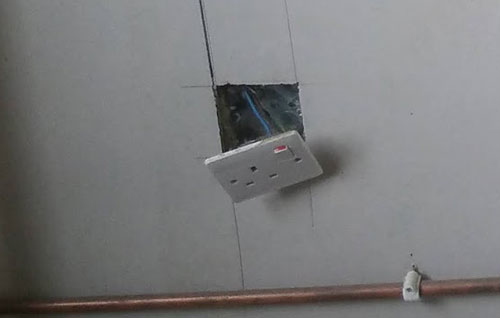
Socket faceplate connected up
Step 5 – Install Junction Boxes
The next job is to strip off each end of the new cable so that each can be connected to a junction box. Unscrew the screw in the junction box cap and remove it and hold the cable against the box to judge how much needs to be stripped off. There should be no core wires showing outside of the junction box so don’t strip too much.
Once the outer sheath is stripped, use wire strippers to strip around 10mm from each core and connect live to one terminal, neutral to the other and earth to another one. Repeat this for the other end of the cable.
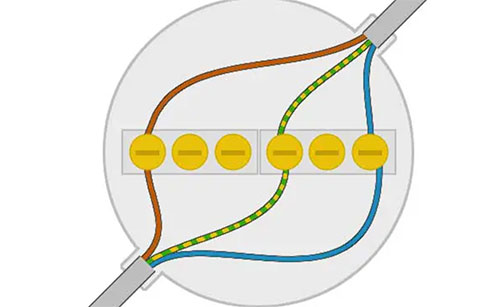
Junction box wired up
Step 6 – Cut into existing Circuit and Connect up
The final job now is to cut the existing ring main and connect each end to a junction box. Before doing anything, isolate the circuit you’re working on in the consumer unit or fuse box.
Once the powers off, the existing ring cable is cut in a suitable place and both ends stripped off using the techniques mentioned above.
Once stripped, connect each end into a junction box and wire live to live, neutral to neutral and earth to earth (don’t forget the earth sleeve). Tighten each terminal fully and then put the cap back on and screw it up.
Once this is done you’re pretty much finished! The final things to do are to get the new circuit fully tested to ensure that all is correct and then you will receive the minor works certificate.
If you have cut any chases you will need to cover over the wires using PVC capping and then these will need to be filled and sanded ready for painting or wallpapering.
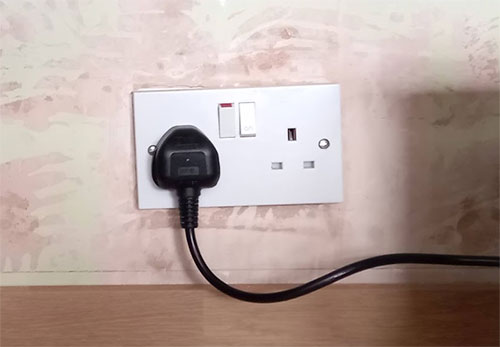
New socket in place on wall
Extending a ring main can be a fairly involved job, but is a necessary one if you don’t have enough sockets in your home. It is absolutely essential though that the circuit is fully tested by a professional electrician once installed to ensure that there are no risks to your insurance or wellbeing on any inhabitants. In pretty much all cases though a professional electrician won’t touch any work not undertaken by themselves as they won’t be able to guarantee how the installation was carried out.

